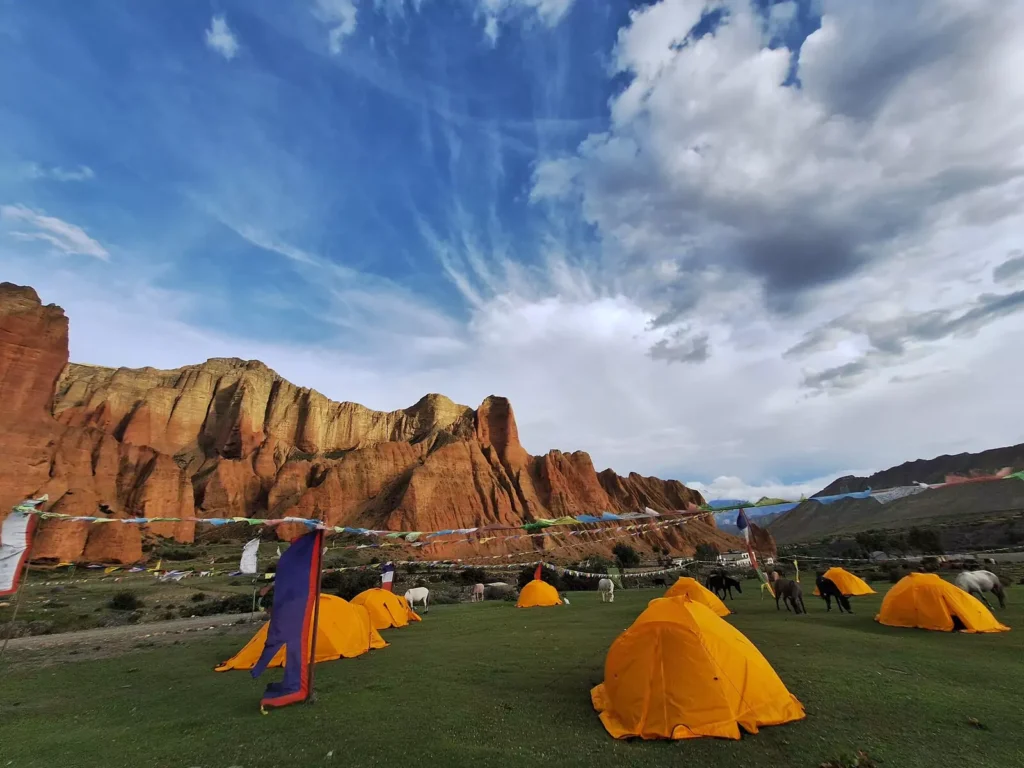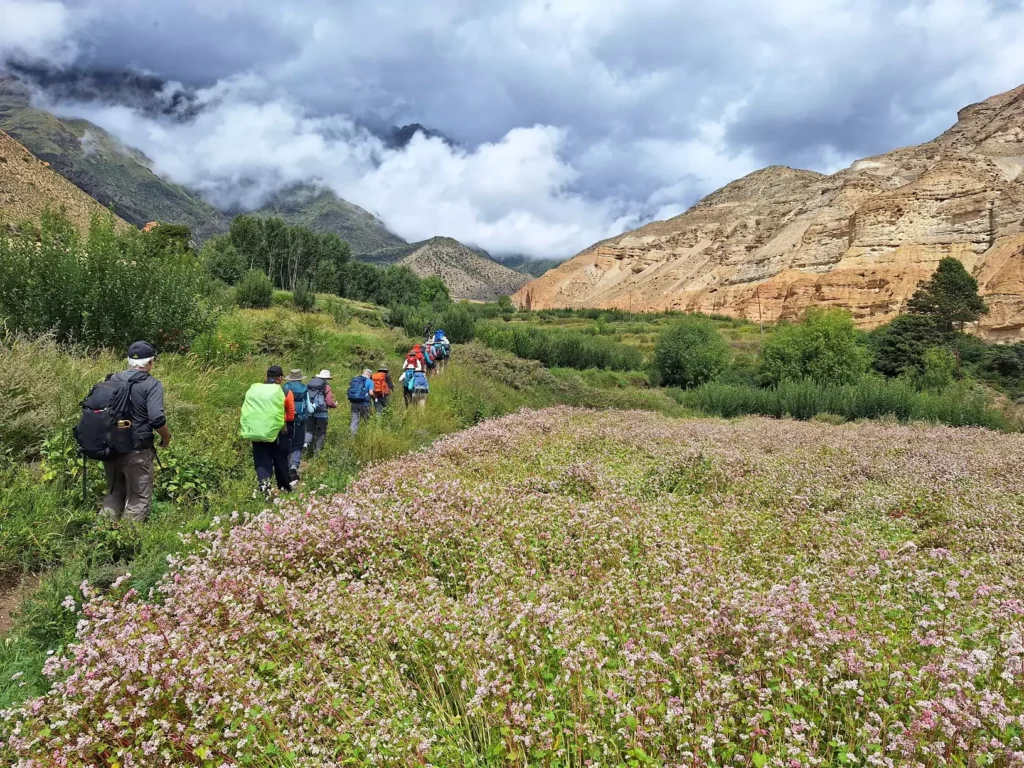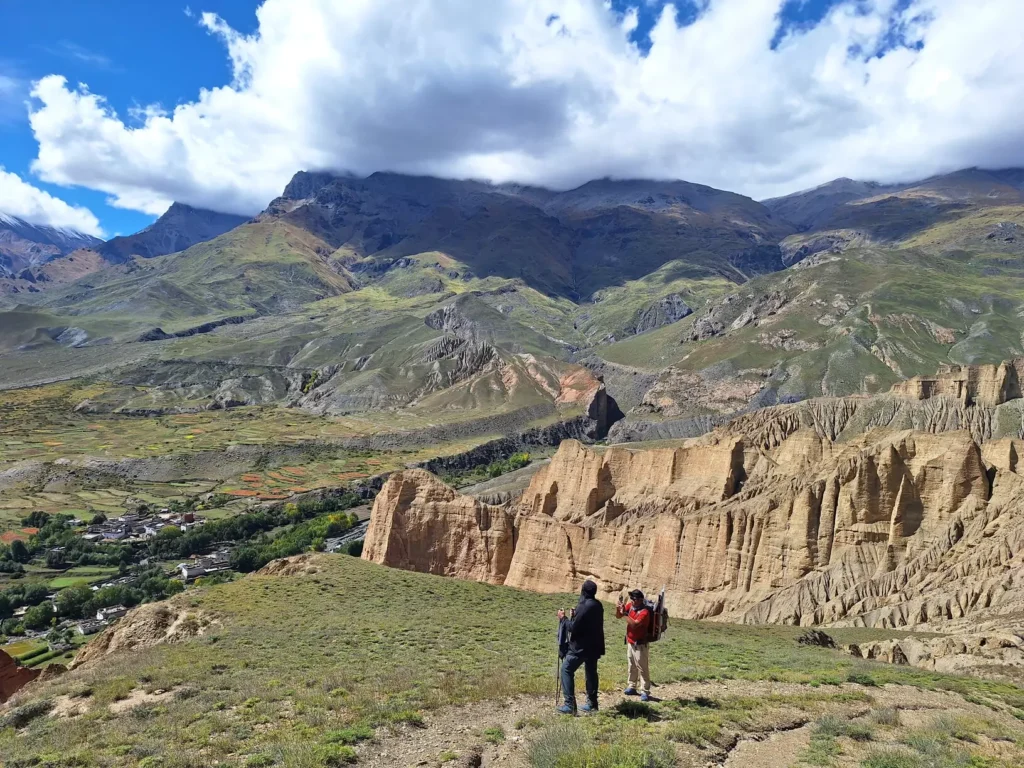Duration
13 Days
Max. Altitude
3810m
Difficulty Level
Moderate to Strenuous
One Way Distance
130Km
Start/End Point
Kathmandu
Best Season
Autumn/Spring
Duration
13 Days
Max. Altitude
3810m
Difficulty Level
Moderate to Strenuous
One Way Distance
130Km
Start/End Point
Kathmandu
Best Season
Autumn/Spring
Overview
The Upper Mustang Trek takes you deep into the heart of a hidden kingdom in Nepal. The Upper Mustang region lies in the rain shadow of the Annapurna and Dhaulagiri mountain ranges, so it remains dry even during the rainy season. Here, you will find vast desert-like valleys, tall orange and red cliffs shaped by the wind, ancient caves carved into rock faces, and sparse vegetation. Walking these trails feels like stepping into a different world. The air is dry and crisp, and the sky often stretches wide and clear above the barren hills.
Mustang was once a separate kingdom with strong Tibetan cultural ties. The people here speak a dialect of Tibetan and follow traditions that have been preserved for centuries. Along the route, you will see old Buddhist monasteries, prayer flags fluttering in the wind, and friendly villagers living a simple life.
The main highlight of this trek is the ancient city of Lo Manthang, the walled city that served as the royal capital of Mustang. It remains a centre of Tibetan culture, spirituality, and history. The city’s white walls, ancient palaces, and colourful festivals make it a magical place to visit.
This Upper Mustang Trek offers a perfect blend of adventure, culture, and natural beauty. It’s ideal for travellers who want to explore a remote area full of stories and tradition while enjoying breathtaking mountain scenery.
Key Highlights
- Fly over Kali Gandaki Gorge: See one of the deepest river gorges on earth from the sky. The flight to Jomsom offers stunning views of sharp cliffs and winding rivers far below.
- Desert-like mountain scenery: Experience an environment unlike most of Nepal with dry hills, wind-eroded cliffs, and vast open spaces.
- Ancient cave dwellings: Walk past caves carved into the cliffs where monks once lived in isolation.
- Remote traditional villages: Visit villages such as Chele, Samar, Ghemi, Tsarang, Dhakmar, and Ghiling. Each has unique traditions, ancient architecture, and warm locals.
- Walled city of Lo Manthang: Explore this old capital’s royal palace, ancient monasteries, and narrow cobbled streets filled with history.
- High mountain passes: Cross passes like Taklam La and Dajori La that offer sweeping Himalayan views.
- Cultural immersion: Witness Tibetan Buddhist festivals, prayer ceremonies, and daily village life in a region with deep spiritual roots.
Trek Itinerary & Route Map
Day 01Arrival in Kathmandu (1,350m)
You arrive at the Tribhuwan International Airport. Your adventure begins in Nepal’s capital city, Kathmandu. After you land, your guide will greet you at the airport. You will be taken to your hotel, where you can rest and recover from your flight. Later, you will meet your trekking team and receive a full briefing about the Upper Mustang Trek. The guide will explain the route, important safety tips, and what to expect in the coming days. You can explore the vibrant city on your own in the evening or relax at the hotel.
Day 02Fly To Pokhara (820m)
Today, you take an early morning flight to Pokhara, a city famous for its serene lakes and mountain views. The flight offers a spectacular view of the Himalayan peaks as you approach the city. Once you arrive, you can stroll beside Fewa Lake, visit local markets, or enjoy a quiet café. Today is the time to prepare mentally for your adventurous trek ahead.
Day 03Fly To Jomsom (2,720m), Drive To Muktinath, Drive To Chele (3,050m), Trek To Samar (3,620m) Via Ghyakar
On this day, you’ll fly to Jomsom, the gateway town to Mustang. The flight lasts about 25 minutes and offers breathtaking views of deep gorges and rugged cliffs.
From Jomsom, you drive to Muktinath, a sacred pilgrimage site for both Hindus and Buddhists. The temple here is known for its 108 holy water springs and ancient stone carvings. After the spiritual visit, you drive to Chele.
Chele marks the official start of the Upper Mustang region. You begin trekking from Chele and pass through rocky river gorges and open valleys as you reach Samar. Samar is a quiet village where the air is fresh and the landscape wild.
Day 04Trek To Syangboche (3,800m), Drive To Ghemi (3,520m)
Today you’ll walk towards Syangboche. The trail from Samar climbs steadily and crosses the two high mountain passes called Taklam La and Dajori La. The path can be rocky and challenging, but the views are worth every step. From the passes, you can see far into the Mustang region and the surrounding Himalayas.
After reaching Syangboche, you will take a short drive to Ghemi. Ghemi is a small village with traditional mud houses, barley fields, and a calm atmosphere. Here you can enjoy a peaceful evening under clear starry skies.
Day 05Trek To Tsarang (3,560m)
Today’s trek leads you from Ghemi to Tsarang. The path follows mani stones and prayer flags along the way. The village of Tsarang is famous for its red monastery and large fortress that overlooks the valley below. The village feels timeless with its Tibetan Buddhist culture intact. Walking here feels like walking back in history.
Day 06Trek To Lo Manthang (3,810m)
You leave early for the final stretch to Lo Manthang. The path passes through the village of Charang. You climb a windy mountain pass before entering Lo Manthang, the walled city. This city is surrounded by tall white walls that once protected the kingdom. Lo Manthang feels like stepping back in time. The whitewashed houses, narrow streets, and fluttering prayer flags create a magical atmosphere. This city was once the capital of Mustang and holds many stories of kings and monks.
Day 07Explore Lo Manthang (3,810m)
Spend the day walking through Lo Manthang. Visit the royal palace to learn about Mustang’s history. Explore Jampa Lhakhang and Thubchen monasteries to see ancient murals and statues. The city is quiet and spiritual. You can meet local families and see traditional crafts. The sunlight hits the white walls and makes the city glow in warm colours.
Day 08Trek To Tsarang (3,560m) Via Ghar Gumba
On the way back to Tsarang, you take a different route via Ghar Gumba. This cave monastery is tucked deep inside red cliffs and is covered with ancient paintings and carvings. It feels very peaceful and untouched. After this special visit, you continue your descent through barley fields and small villages until you reach Tsarang once again.
Day 09Trek To Ghemi (3,520m) Via Dhakmar
From Tsarang, you trek through dramatic red cliffs and narrow caves. You pass Dhakmar, a village famous for its natural beauty and ancient caves used by monks. The trail is peaceful and offers many photo opportunities. You reach Ghemi in the late afternoon and enjoy the calm mountain air.
Day 10Trek To Ghiling (3,570m), Drive To Jomsom (2,720m), Visit Marpha Village
You trek from Ghemi to Ghiling, passing through barley fields and traditional stone houses. Ghiling is a quiet village with friendly locals and warm tea houses. From here, you take a drive back to Jomsom. Visit Marpha village on the way, a charming village known for its apple orchards, old stone houses and local crafts. You can taste local apple products and enjoy the village’s peaceful vibe.
Day 11Fly To Pokhara (820m)
Take a morning flight from Jomsom to Pokhara. From the air, admire the deep valleys and snow-capped mountains. Once in Pokhara, you have a day to relax or explore the charming town with its lakeside cafes and markets.
Day 12Fly To Kathmandu (1,350m)
You fly back to Kathmandu in the morning. Spend your time exploring famous temples, visiting shops for souvenirs, or simply relaxing before your journey home.
Day 13Departure From Kathmandu
You travel to the airport carrying beautiful memories of your Upper Mustang adventure. This journey through rugged mountains and ancient culture will stay in your heart forever.
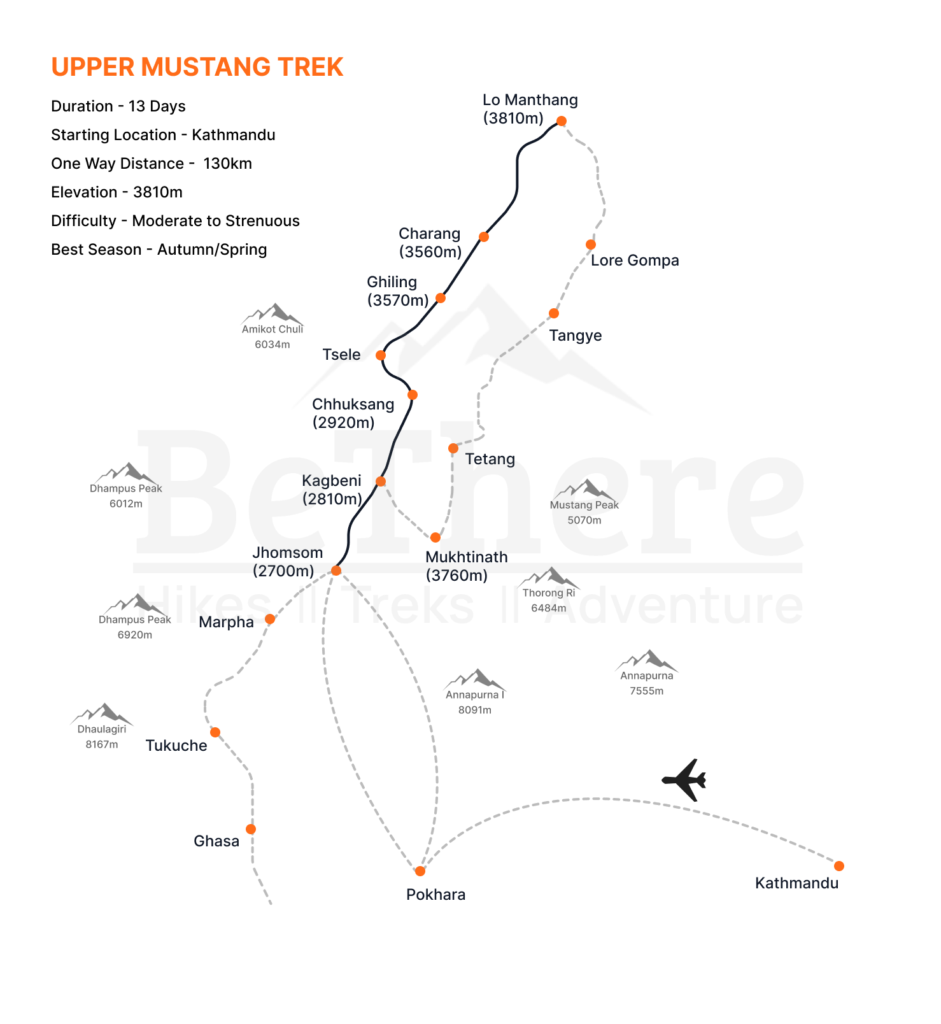
Includes/Excludes for Upper Mustang Trek
- All local flights are included. This includes flights from Kathmandu to Pokhara, Pokhara to Jomsom, and return flights to Kathmandu.
- All drives mentioned in the itinerary, including Jomsom to Muktinath, Chele, and back to Pokhara or Kathmandu.
- A professional English-speaking licensed guide who knows the region well and helps you understand the culture and terrain.
- All Necessary Permits, including the Restricted Area Permit for Upper Mustang and the Annapurna Conservation Area Permit.
- Comfortable stays in tea houses or lodges with twin-sharing rooms and warm bedding.
- You will get breakfast, lunch, and dinner each day with hot drinks like tea or coffee.
- A Basic first aid kit is carried by the guide for safety on the trail.
- All applicable fees are included in the final cost.
- Includes full insurance for the guide and any trekking crew.
- International Flights: Your flight to and from Nepal is not included.
- Nepal Entry Visa: You must get a visa upon arrival at Kathmandu airport or online in advance.
- Lunch and Dinner in Kathmandu and Pokhara: These meals are not included, as you may want to choose your own dining spots.
- Personal Expenses: This includes snacks, drinks, laundry, phone calls, and Wi-Fi during the trek.
- Travel Insurance: You need to arrange travel insurance yourself. Make sure it includes emergency rescue and helicopter evacuation.
- Tips for Guide and Staff: Tips are appreciated but not included in the package.
- Additional Activities: Any sightseeing or activities in Kathmandu and Pokhara that are not mentioned in the itinerary.
Note
Please note that due to ongoing road construction along the Prithvi Highway, the drive from Kathmandu to Pokhara has become more time-consuming and dusty than usual. While this journey typically takes around 6–7 hours, current conditions may extend it to 8–9 hours due to traffic congestion and air pollution. We kindly ask for your patience and understanding during this transitional period.
Gears & Equipment
Item
Quantity
1 set of base/thermal Layer and 1 mid-layer
1
1 Set outer layer
1
1 waterproof jacket and 1 waterproof trousers, or raincoat/punchoo instead.
1
1 pair of lightweight trekking trousers or zip-off pants.
1
2 trekking t-shirts/shirts-merino is ideal
2
Four Season Sleeping bag.
1
Four Season Down Jacket.
1
1 pair liner gloves
1
1 warm wool hat
1
1 sunhat or similar
1
Sleeping bag liner
–
Travel towel
–
Sunscreen
–
Moisturizer
–
Lip Balm
–
Toilet Paper
–
1 rucksack/duffle bag for the porters to carry with your overnight kit
1
1-day pack (approx. 30ltr) with a waterproof cover
1
2 x 1ltr water bottles or CamelBak
2
1 x head torch
1
Water purification tablets
–
1 pair trekking boots (must be worn in)
1
Sandals or hut shoes
–
3 pairs thick walking socks / 3 pairs lighter walking socks
3
Running Shoes or sneakers.
1
Power bank
–
Thermal Flask
–
Adaptors: Nepal uses Type D, C and M
–
Additional Details
Difficulty Level of the Upper Mustang Trek
The Upper Mustang Trek is considered moderate in difficulty. The trails are rocky and sometimes steep, especially near mountain passes. The highest altitude you will reach is Lo Manthang at 3840 meters. The dry climate means the air is thinner, but it is often easier to breathe than in humid places. Physical preparation, such as regular walking, cardio, and leg strengthening exercises, will help you enjoy the trek comfortably.
Trekking Permits Required for the Upper Mustang Trek
The Upper Mustang region is a restricted area, so to enter Mustang, you must obtain a Restricted Area Permit. It costs about 500 US dollars for ten days, with an additional 50 dollars for each extra day. You will also need an Annapurna Conservation Area Permit, which costs around 20 dollars. A local guide is required to visit this region. These rules protect the fragile environment and preserve the unique culture of Mustang.
Best Season To Visit
The best seasons for the Upper Mustang Trek are spring from March to May and autumn from September to November. During these months, the weather is usually clear and dry, perfect for trekking and photography. Mustang lies in a rain shadow, so it receives little rainfall even during the monsoon season. This makes it possible to trek in other months, but spring and autumn are preferred for their pleasant temperatures and views.
Food and Accommodations
You will stay in simple tea houses and lodges along the route. Rooms have warm blankets and pillows, but the nights can be cold, so bringing your own sleeping bag is important.
The food served is mainly traditional Nepali and Tibetan cuisine. Typical meals include dal bhat (rice and lentils), momo (dumplings), and thukpa (noodle soup). You will also find Tibetan breads and drink hot butter tea to stay warm. Hot showers are available at some lodges for a small extra cost.
FAQs
1. How difficult is the Annapurna Circuit Trek?
The Annapurna Circuit Trek is considered moderately to highly challenging. It involves several days of walking, steep climbs, and high altitudes. With good preparation and acclimatization, most trekkers with average fitness can complete it.
2. What is the best time to do the Annapurna Circuit Trek?
Spring (March to May) and autumn (September to November) are the best seasons. These months offer clear skies, pleasant weather, and incredible mountain views. Monsoon and winter are generally avoided due to rain, snow, and trail conditions.
3. Is altitude sickness common on the Annapurna Circuit Trek?
Yes, altitude sickness is a real risk, especially when crossing Thorong La Pass. The trek includes built-in acclimatization days, and it’s important to ascend gradually, drink lots of fluids, and listen to your body.
4. Do I need a guide or porter for the Annapurna Circuit Trek?
As of 2025, hiring a licensed guide for the Annapurna Circuit Trek is mandatory for trekkers to comply with Nepal’s trekking regulations and ensure safety. While porters are not required, they are highly recommended to carry your gear and make the trek more comfortable and enjoyable.
5. What kind of accommodation is available on the Annapurna Circuit Trek?
You’ll stay in teahouses or simple guesthouses run by locals. They provide clean rooms, warm meals, and a place to rest. Most rooms are twin-sharing with shared bathrooms, though private options are available in some villages.
6. What type of food is served during the Annapurna Circuit Trek?
Food options during the trek include traditional Nepali meals like dal bhat, as well as pasta, fried rice, soups, eggs, and pancakes. Meals are made fresh at the lodges and help keep your energy up during the trek.
7. Can I charge my phone and use Wi-Fi on the Annapurna Circuit Trek?
Yes, but the availability of it varies by village. Charging is usually available for a small fee, and Wi-Fi can be found in some lodges. Bring a power bank and expect limited connectivity in higher areas.
8. How should I prepare for the Annapurna Circuit Trek?
You should build your fitness with regular walking, hiking, or cardio workouts a few weeks before the trek. Focus on leg strength, stamina, and getting used to walking with a backpack.
9. What should I do in case of an emergency during the Annapurna Circuit Trek?
In case of an emergency, your guide will assess the situation and take necessary steps, whether it’s administering first aid or arranging a helicopter evacuation. Trekking agencies usually stay in contact with guides via phone or radio. It’s important to have travel insurance that covers high-altitude trekking and emergency evacuation in Nepal.
Need help with your trek?
Reach out to our travel experts
Starts at
USD $1600 $1300 / Minimum 2 Pax
Plan Your Hike

Nepal🇳🇵
What Trekkers are Saying About Us
Bhasmasur Hill was challenging but rewarding with its stunning views. Subash Ghimire’s tips about local culture and nature brought the hike to life for me. It felt like a real adventure, and his friendly attitude kept the group motivated.

Timo Janssen
Traveler from Netherlands
Shivapuri Peak was a perfect challenge for me, tough enough to feel like an accomplishment, but the views were worth every step. The whole experience was seamless thanks to BeThere. They took care of all the planning, so I could just enjoy the hike and nature.

Hannah Brooks
Traveler from USA
Bishnudwar was a quiet, beautiful hike, just what I needed to get away from the daily grind. Alexander Lama knew all the best spots for photos and even pointed out some wildlife. I couldn’t have asked for a better guide.

Nathan James
Traveler from New Zealand
The trail to Nagi Gumba was peaceful and absolutely stunning. BeThere fun made the trip feel so organized and stress-free, from start to finish. I loved being surrounded by nature, just a short drive from Kathmandu.
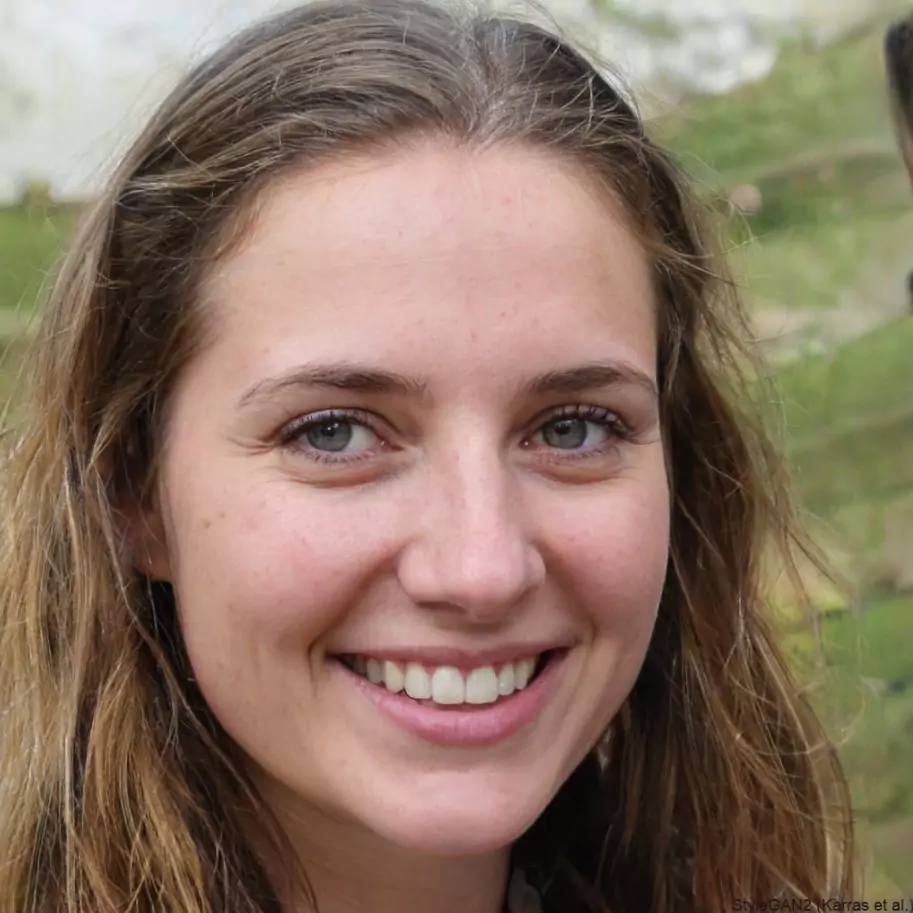
Rachel Bennett
Traveler from UK
Nagarkot was everything I hoped for beautiful forest trails, fresh air, and incredible valley views. The trip was well arranged by BeThere, which allowed me to relax and focus on the experience without any worries.

Felix Schmidt
Traveler from Germany
Lobuche Peak was intense but rewarding. Subash Ghimire made sure we were ready for the climb and kept spirits high with his friendly attitude. This was one of my favorite trekking experiences by far.

Giulia Bianchi
Traveler from Italy
Need help choosing a trail?
Connect with a local and plan your perfect trek.
